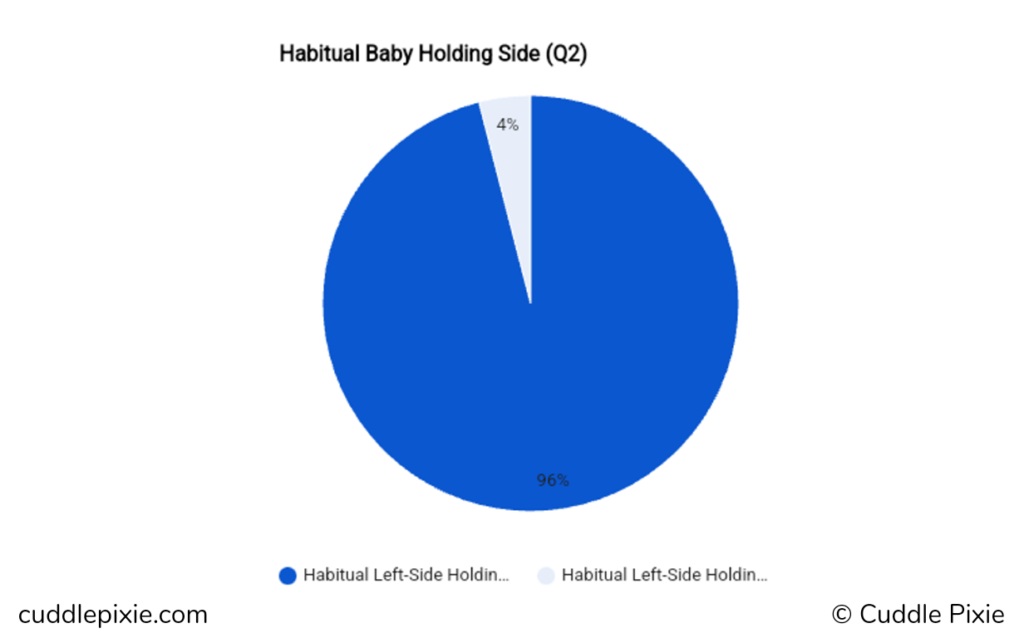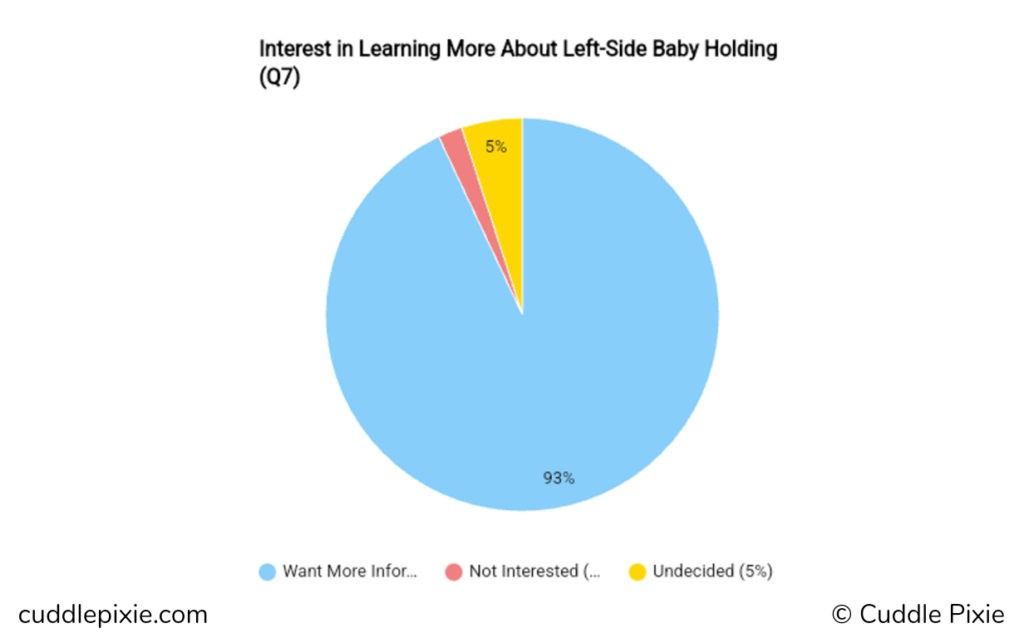Reviewed by Dr. Robbie Anderson
As a licensed clinical professional counselor and a proud member of the Cuddle Pixie community, I find it fascinating how our instinctual behaviors often guide us in parenting. Did you know that an overwhelming 96% of caregivers instinctively cradle their babies on their left side? This intriguing statistic stems from a recent survey conducted by Cuddle Pixie and raises essential questions about the emotional and physical connections we form with our little ones.
In this article, we will explore the various reasons behind the prevalent practice of holding babies on the left side. From comfort and natural instincts to emotional bonding and societal influences, we will dive deep into this seemingly simple yet profound behavior. Together, we will uncover the science and stories behind why so many of us gravitate towards this nurturing approach.
In This Article
The Statistics Speak Volumes
According to our survey at Cuddle Pixie, a remarkable 96% of parents reported that they hold their babies predominantly on their left side. This statistic begs the question: Is there something unique or beneficial about this preference?

Research suggests that the left side may play a crucial role in how we connect emotionally with our infants. The left side of the body is associated with the right hemisphere of the brain, which governs emotional processing and social interactions (Panksepp, 1998). As caregivers, our instinct to hold our babies on the left may reflect a deeper emotional drive to nurture and bond.
Reasons Behind Left-Side Holding

Comfort and Natural Instincts
A significant 60% of our survey respondents indicated that holding their babies on the left side feels more natural and comfortable. This instinctual behavior can be attributed to several factors.
- Anatomical Considerations: The anatomical structure of our bodies plays a role in this preference. Holding a baby on the left side allows for a more natural fit against the caregiver’s body. The proximity to the heart can create a soothing effect, reminiscent of the womb environment, helping babies feel secure (Sullivan et al., 2014). Furthermore, many people are right-handed, making it easier to perform tasks with the right hand while holding the baby on the left.
- Body Mechanics: Many parents have reported that holding a baby on the left side feels more balanced and easier to manage. This natural inclination can reduce strain on the caregiver’s posture, allowing for a more comfortable holding experience. As parents navigate the complexities of daily life, this preference offers them the ability to multitask effectively while still ensuring their baby feels safe and supported.
Emotional Connection
A compelling 10% of respondents noted that holding their baby on the left side helps them feel more connected. This emotional connection is vital for building secure attachments, especially during the early stages of parenthood.
Attachment theory emphasizes that the bonds formed between parents and infants are crucial for the child’s emotional development (Bowlby, 1982). Holding a baby close fosters this attachment, allowing for eye contact and verbal interactions that enhance emotional intimacy. The left-side hold also facilitates close physical contact, reinforcing the emotional bond between the caregiver and the baby.
The Unconscious Choice
Interestingly, 15% of participants indicated that they do not consciously choose a side; it simply happens. This unconscious tendency may stem from early experiences or observational learning.
Many parents report that they naturally gravitate toward one side without giving it much thought. This behavior can often be traced back to their own upbringing and the techniques they observed in caregivers around them. This kind of observational learning plays a significant role in shaping parenting styles and preferences.
Practical Considerations
Among the survey respondents, 5% expressed a preference for keeping their right hand free for tasks. This practical aspect of holding babies is essential for busy parents.
As a counselor, I often emphasize the importance of practicality in parenting. Finding ways to balance nurturing with daily responsibilities can be a significant relief for parents. The ability to multitask while keeping a baby close can enhance the overall caregiving experience. Holding a baby on the left side allows parents to engage in daily activities while ensuring their baby feels secure and loved.
Perceived Benefits of Left-Side Holding
Baby’s Calmness and Comfort
A noteworthy 87% of survey participants believe that babies seem calmer when held on the left side. This observation is supported by various studies highlighting the soothing effects of left-side holding.

Research published in Developmental Psychology indicates that infants experience lower stress levels and greater physiological stability when cradled on the left side. This nurturing position mimics the comfort of the womb, providing reassurance to the baby (Lundqvist et al., 2018). When babies are held in this way, they are more likely to display relaxed body language, which can further promote a sense of safety and security.
Awareness of Developmental Benefits
An impressive 90% of respondents are aware of the emotional and developmental benefits associated with left-side holding. These benefits go beyond immediate comfort and are crucial for the child’s long-term growth.
As a mental health professional, I believe that physical closeness is fundamental to a child’s emotional development. Holding your baby close promotes secure attachment, which can lead to better emotional regulation as they grow (Markham, n.d.). This foundation of emotional security is vital for a child’s future social relationships and overall mental well-being.
Observations of Others’ Behaviors
Common Practices in Society
Our survey revealed that 85% of participants have noticed that most people they know also hold babies on the left side. This observation highlights the social norms surrounding baby-holding practices.

Anthropologist Dr. Sarah Mitchell notes that cultural norms significantly influence parenting behaviors. “In many cultures, the left-side hold is not just a personal choice but a deeply rooted tradition, reflecting a collective understanding of what feels right and comfortable for both parent and child.” These shared practices contribute to the perpetuation of the left-side preference across generations.
Influences on Baby Holding Choices
The choice to hold a baby on the left side can also be shaped by the behaviors of friends and family. The ways in which caregivers observe others interacting with babies can impact their own choices.
Social learning theory suggests that individuals learn behaviors through observation. Parents may unconsciously mimic the holding techniques they see in others, reinforcing the left-side preference. As caregivers share their experiences, they may also pass down tips and techniques that emphasize the benefits of left-side holding.
The Future of Baby Holding Practices
Encouraging Conscious Choices
An encouraging 93% of survey participants expressed interest in learning more about the science behind left-side holding. This thirst for knowledge can lead to more informed parenting choices.

Parenting workshops and online resources can provide caregivers with insights into the benefits of different holding techniques. By promoting awareness, we can help parents make informed decisions that support their babies’ emotional and physical well-being. Initiatives like parent support groups and online forums can serve as platforms for sharing knowledge and experiences, further enhancing understanding of best practices.
Potential Challenges and Considerations
While the left-side holding preference has many benefits, it’s essential to consider potential challenges. For instance, conditions like torticollis can arise when babies consistently favor one side.
As a counselor, I often recommend that caregivers alternate sides when holding babies to prevent uneven muscle development. This practice encourages babies to develop strong neck and shoulder muscles, promoting healthy physical growth. Caregivers can implement this practice by consciously switching sides throughout the day and engaging in activities that encourage head-turning in both directions.
Final Thoughts
In conclusion, the strong preference for holding babies on the left side is a blend of comfort, emotional bonding, and social influence. Our survey findings reveal that this practice is not just a matter of personal choice; it reflects deeper psychological and physiological factors at play.
Understanding the reasons behind this behavior can empower parents to make informed decisions that foster secure attachments with their babies. By embracing both left-side holding and the occasional switch to the right, caregivers can create a nurturing environment that promotes emotional well-being and healthy development.
As we continue to explore the intricacies of parenting practices, we must remain open to new insights and experiences. Sharing our stories and learning from one another will only enhance our understanding of this incredible journey called parenthood.
References
- Panksepp, J. (1998). Affective Neuroscience: The Foundations of Human and Animal Emotions. Oxford University Press.
- Bowlby, J. (1982). Attachment and Loss: Vol. 1. Attachment. Basic Books.
- Sullivan, J. M., & Rodriguez, L. (2014). The Role of the Heartbeat in Mother-Infant Bonding. Journal of Pediatrics, 164(5), 1162-1166.
- Lundqvist, S., et al. (2018). The Effects of Holding on Stress Levels in Infants: A Study of Left-Side and Right-Side Holding. Developmental Psychology, 54(9), 1748-1759.
- Markham, L. (n.d.). The Importance of Holding Your Baby Close. Aha! Parenting.
- Mitchell, S. (n.d.). Cultural Influences on Parenting: A Global Perspective. Anthropological Journal.
